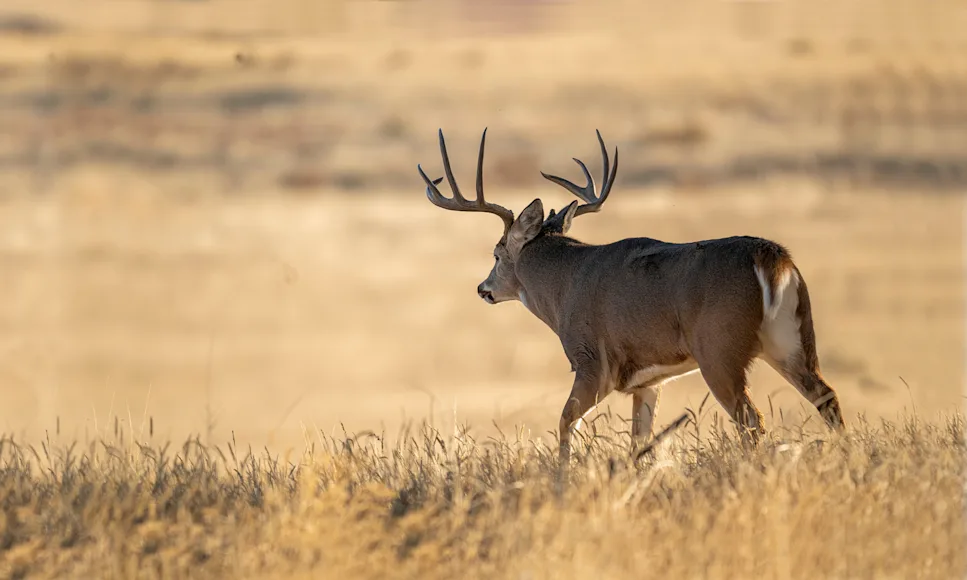It was early November, 2020, just days after I'd arrowed a massive Ohio 16-point at a scrape hub, when my cell camera stationed there lit up. Even from a distance, the new buck’s swollen neck and high, tight rack were impressive. But where on earth had he come from? I'd never seen the buck before, and he vanished as quickly as he’d appeared. I guessed that, if he survived, he might repeat the odd pattern and show up again at the hub—at the same time next season.
So, on a chilly Saturday morning in early November, 2021, that’s right where I was. At 9:30 am, I peered over my right shoulder and, like clockwork, the same buck, with his distinctive tall 10-point rack, was marching toward me, eventually offering a broadside shot at just 8 yards.
The phenomenon of bucks pulling a disappearing act only to magically reappear sometime later is so common it's a cliche around the deer-camp dinner table. But it's always presented a mystery. Do big bucks just have a knack at hiding from us and our cameras, or do they truly shift locations during certain parts of the year? I recently asked this question to a deer researcher whose job entails putting GPS trackers on bucks. His answer may surprise you.
The Latest Science: Sedentary Vs Mobile Bucks

Dr. Bronson Strickland of the Mississippi State University Deer Lab conducts studies on collared bucks. He and his colleague Dr. Steve Demarais, with the help of graduate students, have identified two distinct buck personalities that seem to explain the phenomenon of disappearing and reappearing bucks. Strickland says their studies show that roughly two-thirds of collared bucks fit a personality profile they describe as “sedentary.” These bucks remain within a defined home range and do not typically stray from their core area except for occasional short excursions throughout the year. Because of these homebody traits, these bucks are very predictable and prone to recurrent sightings throughout a hunting season.
The remaining bucks, they call “mobile.” These deer have two distinct home ranges that they live in during different parts of the year and that can be many miles apart. Although not typical, one famous roamer known as Buck 140 traveled 18 miles each year and swam the Mississippi River to go from one home range to another. Within the mobile personality are two sub-categories: the bouncers and the shifters. Bouncers go back and forth like a pinball every few weeks between two areas, whereas shifters stay in each area for extended periods, usually about half the year.

When asked why some bucks show this mobile behavior, Strickland said that it’s not due to seeking alternative food, breeding opportunities, or escaping predators, such as hunters, as far as they can tell. “There appears to be, deep within the genome of a deer, DNA that predisposes some deer to be colonizers or explorers, and some not,” he told F&S. And this seems to explain the sudden appearances and disappearances of bucks that many hunters observe. A buck truly could be miles away living a completely different life, while you sit in your treestand or blind hoping he’ll pop out from behind a bush.
Hunt a Buck by Personality
Given the latest research, it only makes sense to start thinking of—and hunting—sedentary and mobile bucks differently. Here are four tips to that end.
1. Collect Meticulous Intel

The first step is to accumulate data on each buck in your area to start a categorization process. And the more specific, the better. Start creating your database by naming or numbering each buck, and use trail-camera pictures, hunting observations, glassing observations, and boots-on-the-ground intel to gather data points of when, where, and under what conditions they appear. This will take several years to build and should be ongoing, so persist and integrate it in your normal hunting routine.
Related: Best Cellular Trail Cameras, Tested and Reviewed
2. Make Buck Profiles
Once you have a large database you can build profiles of each buck, including any recurring habits, patterns, vulnerabilities, and if they seem to be sedentary or mobile in personality. This is where you can start to differentiate which bucks to target and which may not be worth the effort. Profiles are a vital tool that point to how and when each buck should be hunted based on observed patterns, and, yes, personality.
3. Focus On Homebodies
Since almost 70% of bucks display sedentary traits, and since these bucks are the most predictable in nature, the majority of your efforts should be spent on them. Sedentary bucks can be hunted any time of the year when conditions are right. If you know his home range, favorite haunts and habits, and get a good movement predictor like a cold front, a strategic hunt is a high-odds move. Just be sure his home range overlaps where you can hunt him so you aren’t throwing away precious sits.
4. Anticipate a Mobile Meetup
Avoiding the tricky home-range shifter may be the smart move, as plenty of hunters have wasted their season on such “ghost” bucks. If you decide to go after one though, the trick to tagging a mobile buck successfully is only hunting them when historical evidence is on your side. This is where your previous year’s trail-camera data shines, and, just as with my Ohio 10-point, can help you predict the exact place and time to intercept him. Otherwise, go with the odds and spend your hunts on sedentary bucks. It turns out that bucks do disappear, and satellites prove it. Just like humans, deer have personalities—some you may want to spend your time on, and some you may want to avoid.


